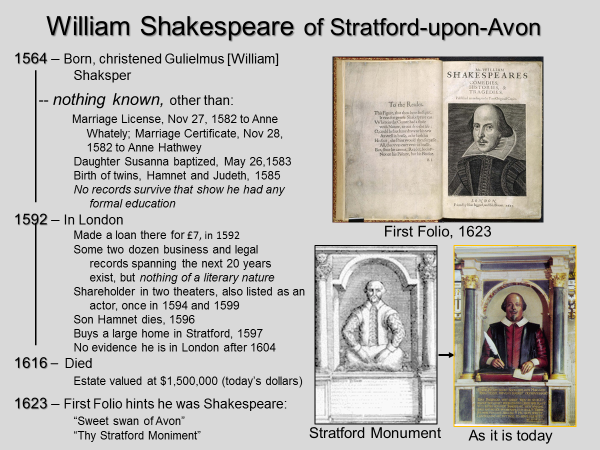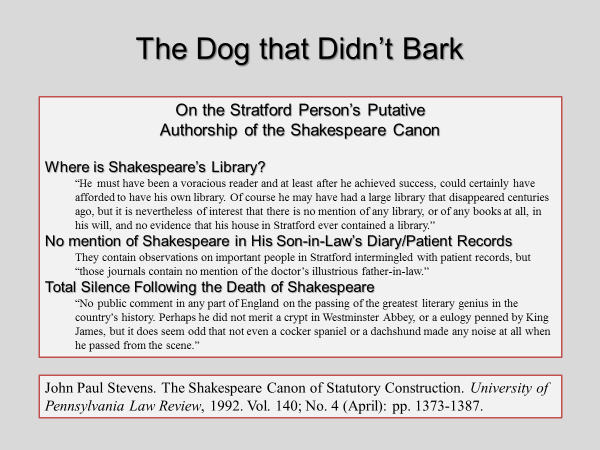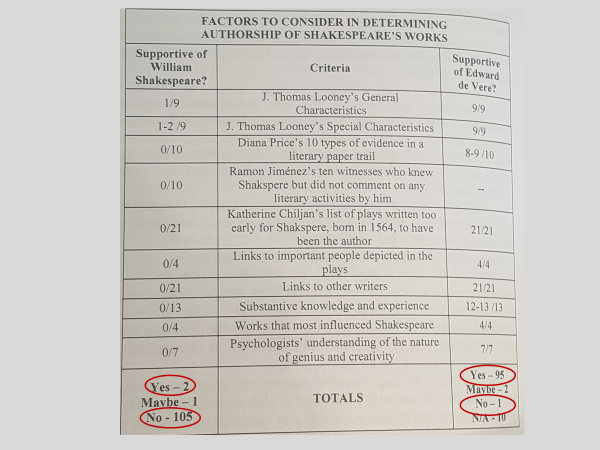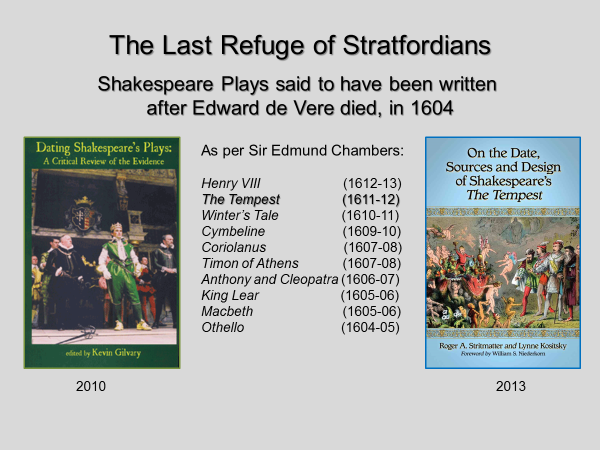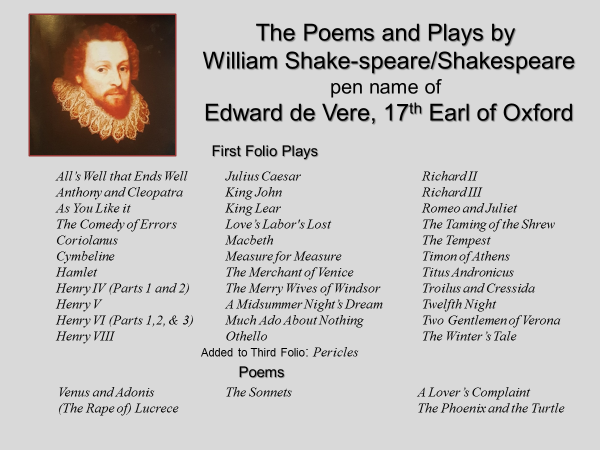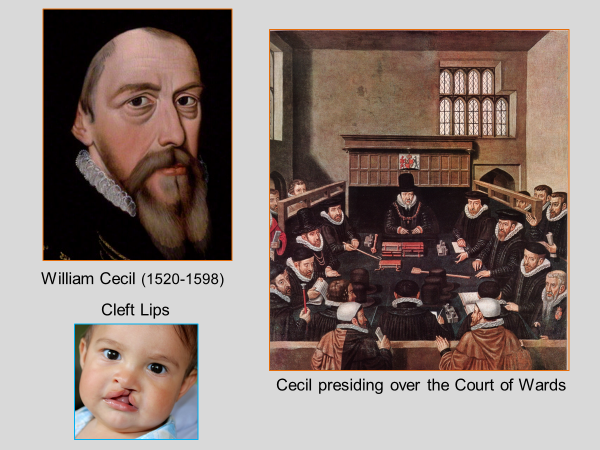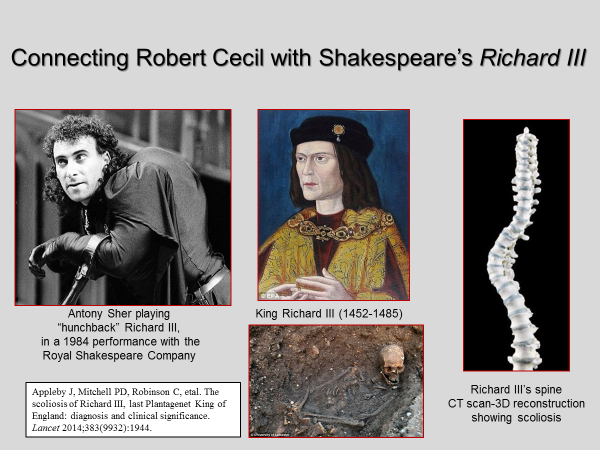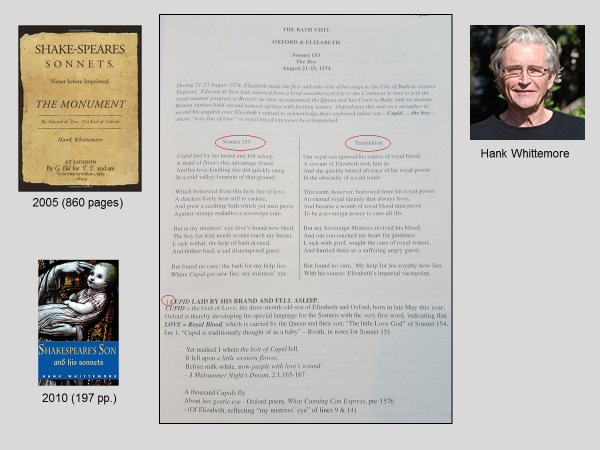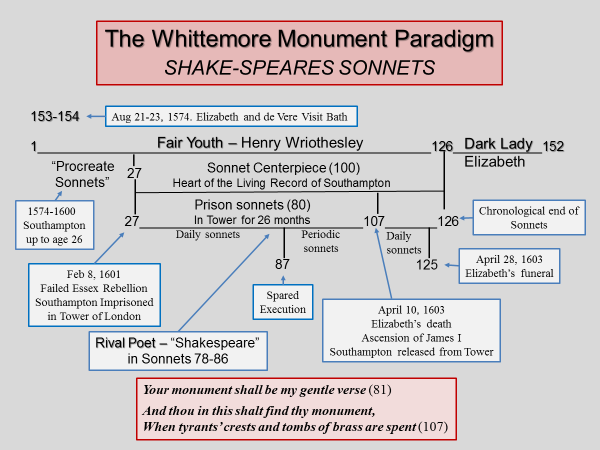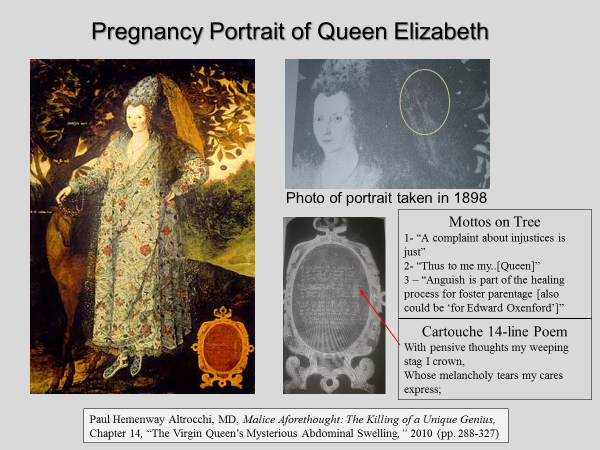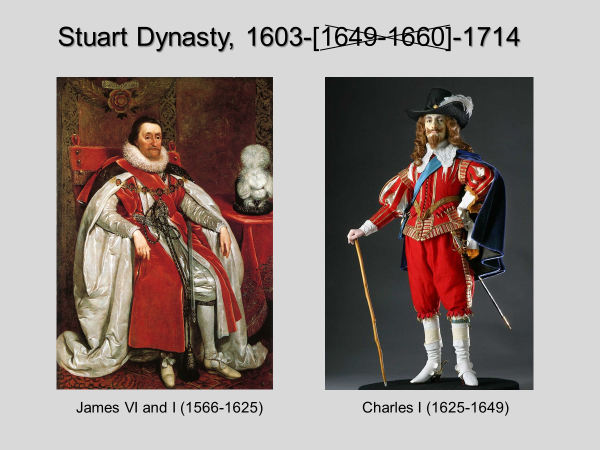This article is taken from a talk I gave on August 13, 2017 at the 35th Annual Meeting of Doctors for Disaster Preparedness in New Orleans. State power affects a lot of the subjects that this group addresses, from climate change and the linear no-threshold model of radiation to saturated fats and DDT. The text includes some of the slides I used for this talk.
Last year the literary world celebrated William Shakespeare on the 400th Anniversary of his death. In the U.S., sponsors had a copy of the original 1623 First Folio of Shakespeare’s plays go on tour and be displayed in all 50 states. In the UK, tourists flooded Stratford-upon-Avon, attending exhibits and activities the Shakespeare Birthplace Trust put on.
The person they celebrate was born in Stratford in 1564 and christened Gulielmus [William] Shaksper. One of eight children, he was the first-born son of John Shaksper/Shakespeare (records spell it both ways), a glove maker and brogger, dealer in wool.
Stratford-upon-Avon then was a small country market-town, a four-day ride from London. Its citizens spoke a unique, Warwickshire dialect of English. The town had no public library and few books. Most of Stratford’s citizens could not read or write, including Shakespeare’s parents, siblings, wife, and children. English then was largely a spoken language.
The town had one grammar school which enrolled 12-24 students, one-twentieth to one-tenth of the boys living in Stratford—and it charged tuition. Fathers groomed their first-born sons to learn and ply their respective trades rather than pay to send them to school and waste their time learning Latin.
The only thing known for sure about the Stratford William Shakespeare’s first 28 years is a marriage license to one woman and a marriage certificate to a different woman issued a day later, followed by the baptism of a daughter six months later, and next the birth of twins. That’s it.
Records show the Stratford William first in London in 1592, age 28, when he made a £7 loan to someone there. Around two-dozen business and legal records spanning the next 20 years show him to be a trader in grain; a money lender; land owner; a shareholder in two public theaters, Blackfriars and Globe; and possibly also a part-time actor. He was a successful businessman and in 1597 purchased the largest domestic house in Stratford, with 30 main rooms. He died in 1616 at age 52, with an estate worth $1,500,000 (in today’s dollars). [1]. Nothing exists from during this person’s lifetime that indicates he might have been a writer.
But front matter in the First Folio published 7 years after he died implies that this Stratford man wrote its plays. In an elegy to Shakespeare, Ben Johnson calls him “The sweet swan of Avon;” and Leonard Diggs, in a poem lamenting his death, mentions “Thy Stratford Monument.” There was a Shakespeare monument in Stratford’s Holy Trinity Church, but it most likely was one of his father John resting his hands on a sack of wool. Years later, officials changed it to show his son William holding a quill pen with the other hand placed on a cushion holding a piece of paper, like it is today.
The Stratford William Shakespeare did not become widely known and accepted as the great author until the 18th century, when in 1709 Nicholas Rowe appended a short (1020-word) biographical appreciation of him in an illustrated edition of the Shakespeare plays. Then, in 1769, actor David Garrick rekindled interest in the Bard and put Stratford-upon-Avon on the map by staging a Shakespeare Jubilee there. It included the firing of cannons; a dinner for 700 people, most of them from London; and a masquerade. Now, 250 years later, Stratford-upon-Avon is one of the biggest tourist attractions in the UK, drawing some 800,000 paying visitors there each year along with 1,000,000 primary school children and generating an annual profit of $12,000,000 (as the Shakespeare Birthplace Trust reports for 2015).
The first book-length biography of the Stratford William Shakespeare, by Charles Knight, appeared in 1843. It unwittingly revealed how little is known about this man. The Stratford William never claimed to have written the Shakespeare plays and poems, nor as a good businessman did he ever seek to profit from the publication or performance of them.
Doubts soon arose about this person being the author of the Shakespeare canon. Literary minds at the time began questioning how an unlettered businessman from a provincial market-town could have written all those erudite, amazing poems and plays.
Henry James (1843-1916) put it bluntly:
“I am ‘a sort of’ haunted by the conviction that the divine William is the biggest and most successful fraud ever practiced on a patient world.”
Mark Twain (1835-1910), in his last book, Is Shakespeare Dead ? ? ? ?, published a year before he died, writes:
“An Eiffel Tower of artificialities rise sky-high from a very flat and very thin foundation of inconsequential facts.” He likens the creation of Shakespeare’s biography to the “reconstruction of a dinosaur from a few bits of bone stuck together with plaster.”
And William James (1842-1910) writes:
“A visit to Stratford now seems to me the strongest appeal a Baconian can make.”
Francis Bacon (1561-1626) became the leading contender for the great author, until 1920.
A schoolmaster in England who taught Shakespeare, J. Thomas Looney, shared these writers’ concerns and set out to find the true author.
Looney (pronounced “Low-knee”) pursued the Shakespeare Authorship Question like a detective investigating a homicide. He studied an anthology of 16th century poetry, searching for any poets who wrote poems in stanzas like those Shakespeare used in his first published work, Venus and Adonis. (Each stanza of this narrative poem has 6 lines in an ABABCC rhyming pattern, with 5 beats—10 syllables—per line.) Looney found only one poem in the anthology written that way, by Edward de Vere, 17th Earl of Oxford. It was on women and titled “A Renunciation.” [2]
Knowing nothing about this earl, Looney put together a list of 18 characteristics the great author would possess, whoever he might be. One is that he would be a member of the higher aristocracy with Feudal connections. A king, emperor, prince, or duke is one of the main characters in 34 of 37 plays. Another characteristic is that he loved Italy. Shakespeare sets 13 of his plays in Italy. Edward de Vere toured Italy, spoke Italian, and lived for a time in Venice. (The Stratford Shakespeare remained in England.)
Novelist John Galsworthy calls Looney’s book on the Shakespeare Authorship Question “the greatest detective story of all time.” Scholar Warren Hope writes, “Looney’s work renders a world figure a nonentity and transforms a forgotten courtier into a leading light of humanity’s intellectual life.” But the literary establishment ignores the book and dismisses it as “looney tunes.”
Over the next 30 years Oxfordian researchers published 91 books on Edward de Vere, along with the first book-length biography, The Seventeenth Earl of Oxford (1928) by B.M. Ward. Other notable early studies include three by Percy Allen and two by Eva Turner Clark [3].
Dorothy and Carlton Ogburn published their 1,297-page book This Star of England: “William Shake-speare” Man of the Renaissance in 1952. Then their son, Carlton Ogburn, Jr. published his 875-page book The Mysterious William Shakespeare: The Myth & the Reality in 1984. While working on it he notes, “In 1974 came the break I had been hoping for.” A Harvard alumnus, he submitted an article to Harvard Magazine, titled “The man who was Shakespeare was not (and who he was).” The magazine’s editor accepted it, writing: “Our magazine is willing and eager to touch the untouchable.” But its readers were not. They were irate. One Harvard professor accused the editor of “irresponsible journalism” and of giving “idiocies a Harvard cachet.” He asked if future articles in the magazine would say that “the earth is flat” and that “Queen Victoria was in fact a Peruvian transvestite.”
But Ogburn Jr.’s book fueled a signal event in the authorship debate, a moot court trial in 1987 sponsored by American University before three U.S. Supreme Court Justices, Harry A. Blackmun (1908-1999)—on the bench 1970-1994, William J. Brennan, Jr. (1906-1997)—on the bench 1956-1990, and John Paul Stevens (1920- )—on the bench 1975-2010. Attorneys representing William Shakespeare of Stratford-upon-Avon and Edward de Vere, the Earl of Oxford were each given one hour to present their case. Justice Brennan presided and ruled “The Oxford side has the burden of proving its case… [and] The burden is one of trying to establish his case by clear and convincing evidence, not simply by a preponderance of the evidence [i.e., more likely than not].”
Following British court practice, each Justice in turn stated his position and reaction to the arguments heard on the case. (British courts, however, do not employ the “clear and convincing” standard of proof, only U.S. courts for settling disputes involving child custody, involuntary commitment, and a few other things.) [4] All three Justices concluded that the evidence presented, in the brief time allotted, did not meet the clear and convincing standard. In his comments on the case, Justice Stevens made this key point: “Oxfordians really have not yet put together a concise, coherent theory that they are prepared to defend, in all respects.”
Five years later, in the University of Pennsylvania Law Review, Justice Stevens observed that three parts of the case are analogous to Arthur Conan Doyle’s dog that didn’t bark (in Silver Blaze, where Sherlock Holmes discerns that the guard dog’s silence indicates it knew the thief who came into the barn and stole a prized horse).
The first silence is that William Shakespeare of Stratford had no library in his spacious home. His otherwise detailed will does not include any books, manuscripts, or writing materials; and 18 plays had not yet been published when he died. His daughter Susanna, questioned years later, said that her father kept no books in his house.
His son-in-law Dr. John Hall, Susanna’s husband and a physician kept a diary that contained patient records and observations on notable people in Stratford, such as Michael Drayton, a poet; the Countess of Northampton, a patron of writers; and the publisher of a French dictionary. He never once mentions his father-in-law in it.
The third silence is most telling. No one noticed or commented on his death. No eulogies. No crypt in Westminster Abbey for England’s greatest poet and playwright.
The Wall Street Journal published an article in 2009 titled: “Justice Stevens Renders an Opinion on Who Wrote Shakespeare’s Plays – It Wasn’t the Bard of Avon, He Says: “Evidence is beyond a Reasonable Doubt.” Justice Stevens affirmed that Edward de Vere was Shakespeare. He said, “Only a nobleman could have produced writings so replete with intimate depictions of courtly life and exotic settings far beyond England.” He stated that Oxfordian researchers had now accumulated sufficient evidence to prove beyond a reasonable doubt—the criminal-level standard of proof—that de Vere was Shakespeare. (The moot court’s Justice Harry Blackman announced in 1992 that he too had become an Oxfordian.)
Oxfordian researcher and novelist James Warren has compiled a list of 108 factors relevant to the authorship question. [5] Some of them are shown here:
In addition to Looney’s 18 characteristics, Diana Price, in her book Shakespeare’s Unorthodox Biography: New Evidence of an Authorship Problem (2001), advances 10 more, beginning with evidence of education. Ramon Jiménez identifies 10 people who personally knew Stratford’s William Shakespeare, but none of them connected him with the great author.
Katherine Chiljan, in her 2011 Shakespeare SUPPRESSED: The Uncensored Truth about Shakespeare and his Works, a Book of Evidence and Explanation, identifies 21 plays written too early for the Stratford Shakespeare, born in 1564, to have been the author. Other factors include known links to other writers and important people depicted in the plays.
James Warren adds 7 factors, which he labels “Psychologists’ understanding of the nature of genius and creativity.” They include “The importance of experience in early childhood [and] necessity of a resource-rich environment;” the fact that “one doesn’t give birth to works of great creativity by accident, but only through years of intense involvement with the subject and determination to produce them;” and “creative geniuses don’t walk away from their work at the peak of their powers.”
Only 2 of these 108 factors support Stratford’s William Shakespeare for authorship of the canon, while 95 of the 98 applicable factors back Edward de Vere as the true author!
With no surviving manuscripts, Stratfordians have labored to ascertain when (the Stratford) Shakespeare wrote his plays. They must fit up to 40 plays into a 26-year time frame, from 1590 (starting at age 26) to 1616 (the year he died). They cite Sir Edmund Chambers “definitive” 1930 study where he concludes that 10 plays were written after 1604, the year de Vere died. Stratfordians point especially to The Tempest, said to be inspired by the shipwreck of the Sea Venture that occurred near Bermuda in 1609.
Debunking this, Roger Stritmatter and Lynne Kositsky prove that The Tempest was in fact written during de Vere’s lifetime, at the latest by 1603. In On the Date, Sources and Design of Shakespeare’s THE TEMPEST, they show that this play is based on Iberian travel narratives translated by Richard Eden in 1555.
In Dating Shakespeare’s Plays: A Critical Review of the Evidence, edited by Kevin Gilvary, scholars show that all of Shakespeare’s plays could well have been written before 1604, some of them when the Stratford William was a boy.
Since Thomas Looney identified the true Bard 97 years ago, scholars have published more than 6,000 articles and 350 books on the Oxfordian theory of the Shakespeare authorship. [6]
Today, armed with Richard Roe’s 2011 The Shakespeare Guide to Italy and Hank Whittemore’s 100 Reasons Shake-speare was the Earl of Oxford, published last year, attorneys representing Edward de Vere in another moot court trial could prove not only in a “clear and convincing” fashion but “beyond a reasonable doubt” that Edward de Vere was Shakespeare.
To maintain in 2017 that William Shakespeare of Stratford-upon-Avon is the great author is Fake News.
But why has it taken 400 years to prove that Edward de Vere was Shakespeare?
Steeped in a rigorous classical education and fluent in six languages, Edward de Vere was the Leonardo da Vinci of the English Renaissance. Like Leonardo, he was a polymath, an expert in many fields ranging from law, medicine, and astronomy to horsemanship and falconry.
Contemporary authors dedicated some 33 books to him. He was the patron of two leading acting companies. When de Vere was 26 years old, in the Queen’s presence, court scholar Gabriel Harvey said to him, speaking in Latin: “These eyes flash fire. Thy countenance shakes speares. Thy splendid fame great Earl, demand the services of a poet possessing lofty eloquence.”
When Edward de Vere was born in 1550 there were no theaters in London. Latin was the language of law, medicine, and formal court life, written and spoken. Fifty year later, at the turn of the century, 10,000 people a week were attending plays in public theaters in London. Edward de Vere turned English into a literary language, inventing thousands of new words. (The first English dictionary was published in 1604.)
Why do historians of the Elizabethan era ignore him? Winston Churchill does not mention Oxford anywhere in his four volume A History of the English-Speaking Peoples (1956-58).
Elizabeth I: A Study in Power and Intellect (1974) by Paul Johnson contains only 7 references to de Vere, ones like: “The Earl of Oxford was the finest dancer, but that did not save him from disgrace when he proved himself a fool and a scoundrel” (p. 215). He was “An arrogant and worthless peer” (p. 252). This, compared with 125 approving references to William Cecil (the power behind the throne); 75 to Francis Walsingham (head of the realm’s spy network); 71 to Robert Dudley, Earl of Leicester; 57, Walter Raleigh; and 43 references to Robert Cecil. Historians dismiss Edward de Vere as the “dissolute” earl.
Proving that Oxford is Shakespeare is not enough. Oxfordians must profer a “concise, coherent theory” on the matter that explains why Elizabethan and Jacobean rulers not only forced Oxford to write under a pseudonym but why they also used state power to erase him from the historical record. The theory must address the state’s motive for doing this, along with the opportunity and means for accomplishing it.
William Cecil, the son of a keeper of clothes for Henry VIII and grandson of an innkeeper was the de facto ruler of England during the first 40 years of Elizabeth’s reign. Dubbed her “Old Fox,” she variously appointed him Lord High Treasurer; Secretary of State; First Minister; and First (Principal) Secretary.
Elizabeth made Cecil a Baron, and he became one of the richest, if not the richest, men in England, if not the richest, with 300 estates and properties listed in his will. He had 80 servants in his London residence and one of the largest libraries in Europe, containing 1,500 books and manuscripts.
Carlton Ogburn Jr. describes William Cecil as “shrewd, calculating, worldly, avaricious, and probably humorless.” Charles Beauclerk, in Shakespeare’s Lost Kingdom (2010), writes: “Cecil’s watchword had always been ‘control;’ he was like a great spider at the center of the web of state, and no vibration of the threads, however slight, escaped his notice.” Cecil employed an army of spies, a forerunner to the surveillance state we endure today.
William Cecil was born with a cleft lip, and likely a cleft palate as well. [7] With speech defects children with this deformity often exhibit behavioral inhibition. But some, like Cecil, do the opposite and display aggressive behavior. As observers have noted, a deformity can be an advantage to a statesman, rendering him industrious and bold, and apt to turn the weaknesses and faults of others into opportunities for retribution. He was also Master of the Court of Wards, which managed and controlled the realm’s finances and lucrative wardships.
His son Robert (1563-1612) had an even more disfiguring condition. He was a hunchback. Only 5 feet 2 inches tall, the same height as Napoleon, Robert Cecil attained even more power than his father. Elizabeth called him her “pigmy.” His biographer P.M. Handover describes him as “crafty” with “a ruthlessness in his character,” and that he “bore the whole weight of the state on his shoulders.” A popular ditty of the time went:
Little Cecil trips up and down.
He rules both court and crown.
William and Robert Cecil followed the Machiavellian principle of “He that gives the means to another to become powerful ruins himself.” They forced “Edward de Vere to the brink of anonymous extinction,” as Dr. Paul Altrocchi puts it in his book Malice Aforethought: The Killing of a Unique Genius. There he writes:
“It is an amazing story—how Edward de Vere’s name and genius were filched and slain by the rapacious unquenchable avarice of a father-son team of amoral politicians. The two Cecils, William and Robert, were so powerful and convincing that the historical truth about the murder of a unique genius—his name and the chronicle of his fascinating life—has been successfully squelched, malignantly distorted and covered up for more than 400 years.”
The Cecils toiled to destroy as many records of Oxford’s life and literary genius as they could find—his private papers, personal letters, and all documents having anything to do with him and his plays, logged in the Revels Office (in charge of court entertainment) or in records of the Privy Council (Elizabeth’s own advisory council).
Edward de Vere didn’t help matters when he turned Richard III into a hunchback, describing him in the play as “this poisonous bunch-backed toad” (I,iii,241-45). Connecting Robert Cecil in this manner with a said to be evil Richard III was not lost on the play’s London audience. (There is no reference to Richard having any deformities in a much earlier version of the play, The True Tragedy of Richard III, that de Vere wrote when he was a teenager. [8]) Cecil got even. He eradicated Oxford’s literary paper trail and largely airbrushed him out of history.
(Richard III was buried in a friary church in Leicester in 1485. In 2012, archeologists located and removed his skeleton at the site of the long-gone church, now underneath the pavement of a car park. Mitochondrial DNA tests on the skeleton compared with that from two direct female-line descendants of Richard’s sister Anne confirmed that it was indeed his remains. A CT scan-3D reconstruction of the spine showed only scoliosis. Richard was not a hunchback. Properly clothed, he would have looked normal.)
One touted objection to Oxford being the Bard are the obsequious dedications Shakespeare writes in his narrative poems Venus and Adonis (1593) and Lucrece (1594) to Henry Wriothesley (pronounced “Rosely”), 3rd Earl of Southampton, his alleged patron. They do not sound like anything the leading earl of the realm with a 500-year history dating from the Norman Conquest would pen to a young nobleman. In Lucrece he writes: “What I have done is yours; what I have to do is yours; being part in all I have, devoted yours.” Henry Wriothesley was not Shakespeare’s patron. He was either a royal prince, and heir to the throne, or he was de Vere’s son. Or both.
The Tudor Heir Theory (also called Prince Tudor) is what Justice Stevens said Oxfordians lacked. This theory explains both why Edward de Vere adopted the pseudonym “Shakespeare” and why William and Robert Cecil strove to erase this earl from history. It postulates that Queen Elizabeth was Henry Wriothesley’s mother, making him the natural-born heir, as King Henry IX, to the Tudor throne. Elizabeth gave birth to him secretively in 1574 and placed him as a royal changeling in the Earl of Southampton’s household. This earl’s wife had recently given birth to a son conceived out of wedlock, who the royal infant replaced. William Cecil’s agent Thomas Dymoke resided there keeping tabs on things. Henry Wriothesley became the 3rd Earl of Southampton following the imprisonment and untimely death, at age 36, of the 2nd earl. Cecil then had Henry, now age 7, come live with him as a ward of the state.
George Orwell wrote that “history is written by the winners.” But one could say that true history is written by the losers, like Shakespeare (de Vere) does in the Sonnets and Solzhenitsyn in the Gulag, on the true history of Soviet Russia.
Shake-speare’s Sonnets and the portrait of a pregnant Elizabeth provide the principle evidence for the Tudor Heir Theory, along with allusions in his poems and plays like the allegorical dirge of the Phoenix and the Turtle, the secret changeling love child in A Midsummer Night’s Dream, the weeping stag in As You Like It, and the strong arm of state power in Titus Andronicus.
With de Vere established as Shakespeare, a concise coherent theory on the matter needs to make sense of Shake-speare’s Sonnets. Oxfordian researcher Hank Whittemore has done that in The Monument (860 pages), published in 2005. He analyzes each line in the 154 Sonnets and the key words in each line.
The Sonnets are not about a sexually charged love triangle, as most scholars think. Whittemore discovered that Shake-speare’s Sonnets is a political statement. Edward de Vere wrote them for future generations, “in hope my verse shall stand” (sonnet 60). His son Henry Wriothesley is the Fair Youth in the piece. The first 126 sonnets are a chronological account of his son’s life.
The first 26 sonnets cover Henry’s birth in 1574 up to age 26 and mainly encourage him to procreate Tudor heirs.
The next 100 Sonnets start with the Essex Rebellion, led by Robert Devereux, 2nd Earl of Essex. Its stated objective was to oust Robert Cecil and break his hold on the Queen. These sonnets deal with Henry’s imprisonment for participating in the rebellion, as second in command; his death sentence; and eventual reprieve. Sonnet 107 reports the death of Queen Elizabeth, “the mortal Moon;” ascension of James I to the throne; and the release of Southampton, all on April 10, 1603.
With James’ consent, Robert Cecil released Henry from the Tower and restored his titles and estates, contingent on de Vere agreeing to remain anonymous, both as author of the Shakespeare canon and father of Elizabeth’s Tudor son.
Sonnets 127-152 focus on the Dark Lady. Scholars have proposed various candidates for the Sonnets’ Dark Lady, but Whittemore shows in a convincing fashion why the Dark Lady must be Queen Elizabeth.
Percy Allen in England first proposed, in 1932, that Henry Wriothesley was Elizabeth’s son by de Vere. Dorothy and Charlton Ogburn reached the same conclusion independently in the U.S., stating this in 1952. But it wasn’t until Hank Whittemore deciphered the Sonnets in 2005 that there existed sufficient evidence to prove this to be true (at least on a more likely than not basis).
Then there is this portrait of Queen Elizabeth, which Dr. Altrocchi dubs “The Virgin Queen’s Mysterious Abdominal Swelling.” Although recognized as a portrait of Queen Elizabeth I for more than 300 years, curators of the Royal Collection at Hampton Court Palace, where the painting resides, have titled it “Portrait of an Unknown Woman.” On the Royal Collection’s website under the portrait one finds this statement: “Long thought to have been a pregnant Queen Elizabeth I owing to the frame having a plaquard saying Queen Elizabeth, it is now believed to have been a swapped frame.”
Oxford most likely commissioned the Tudor Court’s Flemish artist Marcus Gheeraerts the Younger to paint this portrait showing a pregnant Queen standing next to a weeping stag and crowning it with a garland of pansies. (This alludes to Book 3 of Ovid’s Metamorphoses, where the Goddess Diana transforms Actaeon into a silent, weeping stag for seeing her bathing nude in a stream.)
Along with other features of a symbolic nature, the cartouche on the bottom right contains a 14-line Shakespearean sonnet, where de Vere describes the Queen’s pregnancy by him and his sadness over the loss of his son to her royally-commanded foster parentage. Its various owners have had approximately 30 percent of the portrait painted-over to cover-up the subject’s identity. A photograph of the painting taken in 1896 shows a capital “R” for Regina on her upper veil that has been erased.
Robert Cecil blocked Henry Wriothesley from ascending to the throne because he could not control him and preserve his own vast power and wealth nearly as well as he could by arranging to have the more malleable James VI of Scotland become James I of England. Writing home the Venetian ambassador observed: “His majesty is devoted to the chase and to his pleasures, and readily leaves all to the Council… the Lords… Greatest and most eminent of all is Robert [Cecil]… whose authority is so absolute that he may truly be called King.”
Anglo-American history would have taken a different course if the Tudor line had continued under the Henry IX and his heirs. Instead, Charles I, succeeding his father on the throne from 1625 to 1649 when he was beheaded, held an even more absolutist view of kingship. He shut down Parliament in 1629. And for the next 11 years ruled without a legislature, eschewed common-law jurisprudence, and governed through proclamations, like a sacred monarch on the Roman model. As a result, between 1629 and 1640 more than 20,000 Puritans fled England for America, turning what had been small, fledgling settlements into permanent American colonies. Had the Tudor line continued with King Henry IX and his descendants, Charles would not have lost his head and the English Civil War, fought from 1642 to 1651, most likely would not have happened. Colonization of America would have taken a different course.
Future generations, I believe, will celebrate three pivotal years on Shakespeare: 1623, when the First Folio of his plays was published; 1920, when Thomas Looney identified their true author, Edward de Vere; and 2005, when Hank Whittemore unlocked and made sense the Sonnets and unveiled the true history of state power and Shakespeare.
References
- J. Pointon. The Man who was Never SHAKESPEARE (2011)
- Francis Turner Palgrave. Golden Treasury of Songs and Lyrics Book 1 (1903)
- They are:
Percy Allen. The Case for Edward de Vere, 17th Earl of Oxford, as Shakespeare. London, 1930.
The Oxford-Shakespeare Case Corroborated. London, 1931.
The Life Story of Edward de Vere as “William Shakespeare.” London, New York, 1932
Eva Turner Clark. Hidden Allusions in Shakespeare’s Plays: A Study of Early Court Revels and Personalities of the Times. New York, 1931
The Man Who Was Shakespeare. New York, 1937
- Miller DW, Miller CG “On Evidence, Medical and Legal.” Journal of American Physicians and Surgeons 2005;10(3):70-75. Available at: http://www.jpands.org/vol10no3/miller.pdf
- James A. Warren. Summer Storm: A Novel of Ideas, 2016.
- James A. Warren. An Index to Oxfordian Publications. Third Edition, 2015.
- Paul Hemenway Altrocchi. Malice Aforethought: The Killing of a Unique Genius, Chapter 11, “An Untold Story in Plain Sight.”
- Raymond Jiménez. “The True Tragedy of Richard the Third: Another Early History Play by Edward de Vere.” 2007 Available at; https://shakespeareoxfordfellowship.org/true-tragedy-of-richard3/
Recommended Reading
Five Good Books the Shakespeare Authorship Question
Shakespeare: WHO WAS HE? The Oxford Challenge to the Bard of Avon (1994, 170 pp.) by Richard Whalen. My path to becoming an Oxfordian began in 1995 when I came upon and read this book. A concise, well written, and evenhanded presentation of the evidence showing that Edward de Vere, the Earl of Oxford was the genuine author of the Shakespeare canon. (Joseph Sobran’s 1997 Alias Shakespeare: Solving the Greatest Literary Mystery of All Time is another good introduction to the Oxfordian theory of the Shakespeare authorship. But, unfortunately, he misinterprets the Sonnets; and, as others have done, he thinks the Poet and the Fair Youth of the piece are gay.)
The Man who was Never SHAKESPEARE (2011, 380 pp.) by A. J. Pointon. Arguably the best biography of Stratford-upon-Avon’s successful businessman William Shaksper/Shakespeare.
The Shakespeare Guide to Italy: Retracing the Bard’s Unknown Travels (2011, 297 pp.) by Richard Paul Roe. “Smoking gun” evidence that Edward de Vere is William Shakespeare.
Malice Aforethought: The Killing of a Unique Genius (2010, 395 pp.) by Paul Hemenway Altrocchi. A great read, fascinating, very informative, and true. Dr. Altrocchi received his M.D. degree from Harvard and did his residency training at Columbia, like me, and was a Professor of Neurology at Stanford before he retired to work full time on the Shakespeare Authorship Question.
100 Reasons Shake-speare was the Earl of Oxford (2016, 351 pp.) by Hank Whittemore. He nails it! He proves beyond a reasonable doubt de Vere is Shakespeare.
Making Sense of the Sonnets: Four books on The Whittemore Monument Paradigm
Shakespeare’s Son and his sonnets (2010, 197 pp.) by Hank Whittemore. An expanded introduction to The Monument. A good place to start.
The Monument (2005, 860 pp.) by Hank Whittemore. The complete work. In all its magnificence.
Hidden in Plain Sight: The True History Revealed in Shake-speares Sonnets. Second Edition (Revised). (2016, 363 pp.) Rush explains well the Monument Paradigm for the general reader and further develops it. Highly recommended.
A Poet’s Rage: Understanding Shakespeare through authorship studies. (2013, 257 pp.) William Boyle, Editor. Eleven essays and two appendices on the Tudor Heir (Prince Tudor) theory and the Monument. The essay by William Boyle, “Unveiling the Sonnets” is excellent and worth the price of the book.


